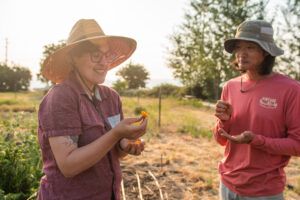
Hello, again. I’m Sophia Nowers, the summer intern for Oregon State University Extension Service’s Small Farms Program and Community Horticulture in Benton, Linn and Lane counties. It is hard to believe that I’m already in the last week of my internship. The past month has sped by in a blur of events and activities. I have tabled at the Benton County Fair, helped on Small Farms farm tours, gone to OSU field days, and worked with Master Gardeners to publicize some of their events and talks. Between writing up summaries of events for sharing on social media and in Extension publications, I have also been working on an article about the OSU Dry Farm Project and its community involvement through the Dry Farming Collaborative.
It has been fantastic to explore Extension this summer, especially as an OSU student in the College of Agricultural Sciences. I have had the opportunity to make so many connections with professors, researchers, and members of the community and it has given me a strong sense of what I might want to do in the future.
There have been so many highlights, from getting to bottle feed a two-day old baby goat to attending the Organic Grains & Pulses Field Day and several Master Gardener events. My favorite part of my internship was learning how Extension bridges the gap between communities and the university, connecting researchers with farmers and business owners, community members with resources about gardening and homeownership and farmers with each other. I am grateful for the opportunity to help publicize Small Farms Program and Community Horticulture’s events and activities.
The project that I am proudest of is my article about the OSU Dry Farm Project. For the article, I interviewed the lead researchers of the project, Lucas Nebert and Matt Davis, visited two of their dry farm sites, and in the process learned a lot about dry farming and its challenges in Oregon.
I am grateful to my supervisors, Teagan Moran and Brooke Edmunds, for their support and guidance this summer, and to everyone I met through this internship. I have greatly enjoyed exploring some of what Extension has to offer and realizing that there is so much more!














